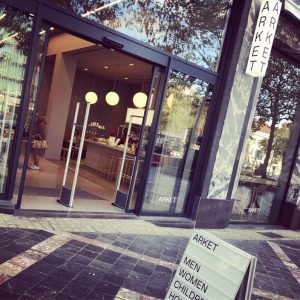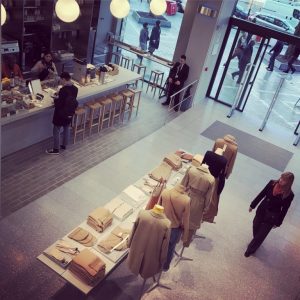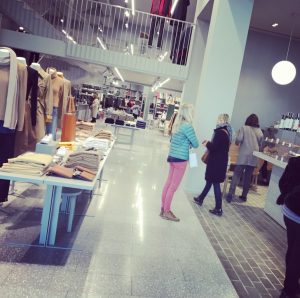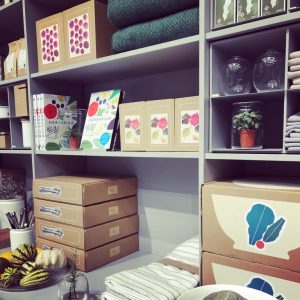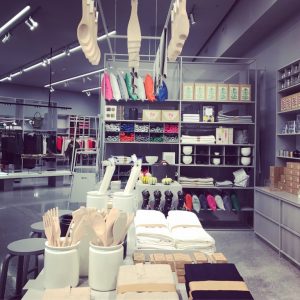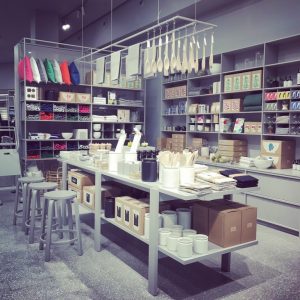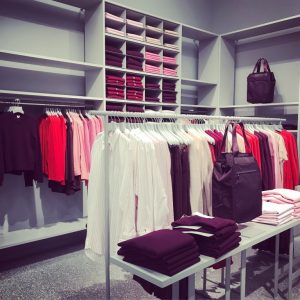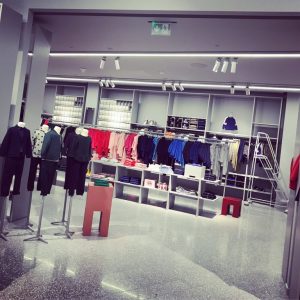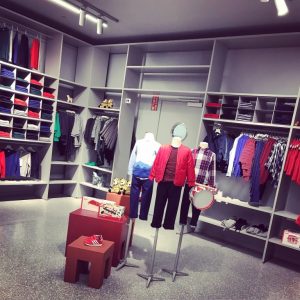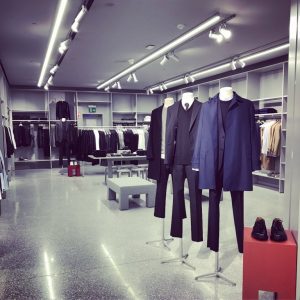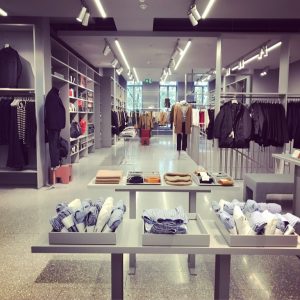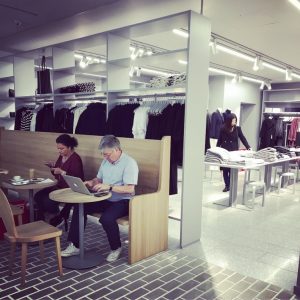When people think of “slow fashion,” it’s often perceived as high-end, expensive, and inaccessible. This is not entirely off the mark. Many luxury brands employ tailors and seamstresses who carefully craft garments with superior textiles and incorporate iconic or timeless designs which make them more like historical artifacts, are all part of the DNA of slow fashion. It reminds me of a quote from Vivienne Westwood: “Buy well, choose well, make it last.”
This quote may resonate stronger with younger generations as we see trends shifting toward more conscious consumers. We have also witnessed more and more slow fashion brands hitting the web and the streets. While brands like Eileen Fisher, often considered the “mother” of slow fashion, have been successful for years, other slow fashion brands (like NAU, that arguably opened its doors before its time) have found success with online audiences and through the occasional pop-up. Another example is Everlane, which engages younger generations through its designs, radical transparency, and pricing, which has reached beyond its online presence to open its first store in New York at the end of 2017. Its San Francisco flagship in the mission district is slated to open this month.
When you hear the company name H&M, your first thought most likely isn’t sustainability. And certainly you don’t associate it with slow fashion. On the contrary, it’s considered to be a fast fashion brand producing mass amounts of inexpensive trendy garments. When you say H&M, you might remember the hype around the brand’s opening of its New York store in 2000 and the joy of hearing their plan for rapid expansion. But that was 18 years ago, and consumer mindsets have shifted.
Responding to the changing times, the Swedish-based brand launched its first “conscious collection” made from sustainable materials in 2010, and they’ve been collecting used clothing for recycling since 2013. Even with these initiatives, the retailer is still recognized as fast fashion. And these kinds of brands have been closing up shop. In fact, Bloomberg reported this past January that H&M will be closing 107 stores in 2018, the most for the brand since 1998.
Despite this downsizing, the H&M Group is planning to continue expanding their other “sustainable” independent brands and is even introducing a new one to the European market. Its concept COS (circa 2007), promotes wardrobe essentials that are intended to last beyond the season. The minimal understated aesthetic of its garments and store design is timeless, much like the architecture and culture the Scandinavian-based parent company. With 14 stores currently in the U.S., look for more to open in the future, beginning with Chicago in May.
In 2013, the H&M Group launched its second independent branch, & Other Stories. This ready-to-wear collection targets younger female consumers with three design ateliers in Paris, Stockholm and Los Angeles. While H&M closes many of its fast fashion stores, it is these slow fashion concepts that are revolutionizing both the apparel industry and the store experience.
Advertisement
Another store I hope to see realized in the U.S. is Arket. The concept is intended to be a “modern day market” and another slow fashion brand. Its website states that Arket’s mission is to “democratize quality through widely accessible, well-made, durable products, designed to be used and loved for a long time.” This mission certainly resonates with everything we know about millennials and Gen Z. Opening its first stores in the fall of 2017, two in London (Long Acre & Regent Street), and others in Brussels, Copenhagen, Munich and Stockholm, Arket’s store design may just provide the glimpse into how the slow fashion movement will influence the future of retail.
While in Europe for the PLATE Conference this past November, I got to experience first-hand three of the six store locations.
The two-story Brussels location, similar to that of the Regent Street store, utilizes minimal exterior signage and replacing the typical window display with a view into a café, Arket creates a human moment by placing people at café’s bar height seating. Introducing the café at the forefront of the customer journey is the first unique element you’ll notice, which sets the tone for the store experience. From the entry, you immediately smell the fragrance of roasted coffee beans, fresh baked pastries, and the zest of lemon dressing being made for a seasonal salad. Though greeted by a small display of the latest garments in the new colorway, the café and its organic, seasonal, healthy food menu immediately projects the brand’s core values and allows the customer to begin a journey of discovery. Another surprise from their café was the cross-generational appeal: There were older adults enjoying coffee and a book alongside younger patrons having lunch after making their purchases. (Quite a creative way of bringing potential new customers in their front door.) In many ways, this is reminiscent of IKEA, where some people go for dinner regularly.

Photography: Rebekah L. Matheny, Columbus, Ohio

Photography: Rebekah L. Matheny, Columbus, Ohio
The cool, mid-toned gray used as a solid color or as a texture through the wall paint, concrete floor tiles, marble countertop, and steel throughout the entire design is balanced with the warmth of the wooden fixtures, furniture and lighting with warm color temperatures. If you look closely, what appears to be a continuous, exposed aggregate concrete floor, is actually tiles in various sizes. It’s this attention to detail in the material selections that echo the refined details in the brand’s clothing designs. The quality of the materials used as a continuous thread throughout establishes a tone of quality and durability that is essential to the brand’s values.
Advertisement

Photography: Rebekah L. Matheny, Columbus, Ohio
Continuing along the customer journey, one would think that the next stop would be women’s apparel. Instead a winding staircase creates a physical threshold, indicating that you can proceed upward toward the men’s collection while also creating a moment of pause through the stair’s compression of space., This allows for a defined area featuring a mix of androgynous clothing and accessories; after that comes the homewares section. (Though the products are simple, the packaging’s use of color and pattern is reminiscent of another Scandinavian brand, Marimekko.)

Photography: Rebekah L. Matheny, Columbus, Ohio
Beyond the home collection is the women’s apparel. At the forefront, on a low display that doesn’t obstruct the view of the garments, a natural skincare collection is introduced. The simplistic yet artistic display highlights its development by a French biochemist and perfumer, reiterating the brand’s commitment to transparency and integrity.

Photography: Rebekah L. Matheny, Columbus, Ohio
Similar to COS, Arket’s approach to slow fashion is through creating timeless silhouette in classic colorways. The store is designed to feature these color collections, creating cross-merchandising grouping in monochromatic zones which pop off the neutral gray palette of the interior space and fixtures. Contributing the flow is the strategic central angled display, which opens up sightlines and directs the shopper. Following the angled elements, the use of light (track lights paired with a linear fixture) creates a visual contrast to the gray ceiling and a reflection off the concreate floor tiles which helps supports the customer journey.
Advertisement
Both the children’s section and the men’s section repeat the same strategy and design elements as the women’s section.

Photography: Rebekah L. Matheny, Columbus, Ohio

Photography: Rebekah L. Matheny, Columbus, Ohio
Thinking back to a conversation I had at the beginning of the semester with my retail studio students (millennials and Gen Z students), some of the attributes they used to describe their brand affinities were: minimal, long lasting, transparent, quality, affordable, sustainable and responsible. Through its store design, product design and selection, and inclusion of the café, Arket hits all of these attributes spot on. Certainly, the overall aesthetic is reflective of its Scandinavian roots. How could these attributes be applied to other brands? Like H&M, could other fast-fashion parent companies begin to transition toward a slow fashion future by creating new branches?

Arket Long Acre Store, London. Photography: Rebekah L. Matheny, Columbus, Ohio
Rebekah L. Matheny is the assistant professor of interior design at The Ohio State University (Columbus, Ohio), where she teaches courses in interior finish materials, lighting design and design studios that integrate a retail brand strategy process. Matheny’s research investigates the sensory perception of interior finish materials and their application in retail design to create an emotional connection between the customer and the brand. Through her research and teaching she strives to pave a path to a more environmentally and socially sustainable retail culture.


 Photo Gallery3 days ago
Photo Gallery3 days ago
 Headlines2 weeks ago
Headlines2 weeks ago
 Sector Spotlight2 weeks ago
Sector Spotlight2 weeks ago
 Headlines1 week ago
Headlines1 week ago
 Headlines5 days ago
Headlines5 days ago
 Headlines2 weeks ago
Headlines2 weeks ago
 Designer Dozen1 week ago
Designer Dozen1 week ago
 Headlines3 days ago
Headlines3 days ago









